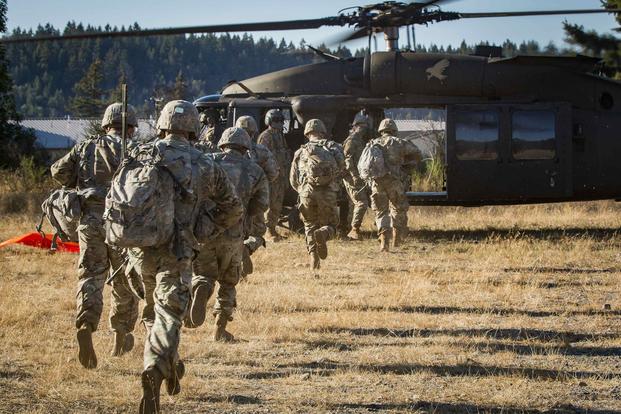Maneuver officials at Fort Benning, Georgia, are looking at restructuring future ground combat units, including an effort that could change the size of the infantry squad.
For the past three years, the Army has been rushing to perfect new, advanced weapons and other sophisticated battle technology to prepare for large-scale combat with potential adversaries such as Russia and China.
Now, the service is looking at how new systems, ranging from the Robotic Combat Vehicle to the Next Generation Squad Weapon, could affect the size of maneuver units, starting with the nine-man infantry squad, Col. Alexis Rivera Espada, director of the Maneuver Battle Lab at Benning, said this week at the National Defense Industrial Association's Armaments, Robotics and Munitions conference.
Read Next: Army Still Wants a Precision Infantry Weapon to Destroy the Enemy From Behind Cover
Maneuver officials will support an Army-directed "squad study of the first of its kind in many decades, to determine the optimal size of the infantry squad using next generation capabilities," Rivera Espada said.
"This is one that I think will gain a lot of interest as we move forward with this," he said, describing how Benning's Live Experimentation Branch will conduct a live experiment in support of the squad study in fiscal 2021.
Army Infantry School Commandant Brig. Gen. David M. Hodne said the squad study, which will be run by the Soldier Lethality Cross Functional Team and the Maneuver Capabilities Development and Integration Directorate, "is overdue" but cautioned that the squad is not likely to shrink below nine soldiers.
"From our initial results through experimentation, we do know that reducing the squad to less than nine soldiers is not a good idea and will not recommend reducing the size of the current rifle squad," Hodne said in a statement.
This study will consider the impact of equipping the squad with "next-generation capabilities," such as the Next Generation Squad Weapon, a 6.8mm weapon system being designed to replace the M4A1 carbine and the M249 squad automatic weapon, and the Integrated Visual Augmentation System, a system being developed to equip soldiers with a heads-up display to show maps and other key tactical information, said Hodne, who is also the director of the Soldier Lethality Cross Functional Team.
"However, even if experimentation indicates an 11-soldier squad is optimal, this might not result in adjusting the size of the squad, given several factors -- (force structure constraints, personnel costs, and even vehicle design limitations)," he wrote.
Hodne's reference to vehicle design limitations refers to the Next Generation Combat Vehicle, which the Army is designing to carry a nine-soldier squad, to replace the Bradley fighting vehicle.
The Marine Corps has experimented with changing the size of some of its 12-member infantry squads to 15 members, an effort former Commandant Gen. Robert Neller launched in 2018.
In 2018, Neller also reduced the size of all infantry squads from 13 Marines to 12 and restructured them to include three, three-man fire teams, in addition to a squad systems operator, assistant squad leader and squad leader.
The Army is also likely to move from a brigade combat team focus to a divisional structure as it prepares for war in the future, Maj. Gen. Patrick Donahoe, commander of the Army Maneuver Center of Excellence at Benning, said at the NDIA conference.
"As we look at our organizations, the United States Army is, I think, on the cusp of declaring the division as the unit of action," Donahoe said. "We understand that large-scale combat operations [are] no longer a brigade-centric fight. The brigade will not have enough combat power. The brigade will not have the ability to synchronize all the elements of combat power that will be required to fight and win in large-scale combat operations."
The Army moved to a BCT-focused structure in the early days of the war in Iraq and Afghanistan to be able to create deployable force packages to feed the back-to-back combat rotations based on the readiness of individual BCTs across the Army. It was not unusual for a BCT from the 82nd Airborne Division at Fort Bragg, North Carolina, to be paired with a BCT from the 10th Mountain Division at Fort Drum, New York.
Army BCTs "will probably be smaller" and will have to be augmented with other units, such as artillery and reconnaissance support from the division level, Donahoe said, adding that BCTs will be the "landing place" for new autonomous systems such as the Robotic Combat Vehicle, which is being designed to give commanders the option of sending unmanned vehicles in first to face enemy formations.
"The brigade combat team will still be central to what we do, and it will still be incredibly important that it is a fully-functioning combined-arms brigade that can close with and destroy the enemy in close combat," Donahoe said.
-- Matthew Cox can be reached at matthew.cox@military.com.
Related: It's Official: Top Marine Wants 12 in an Infantry Squad











